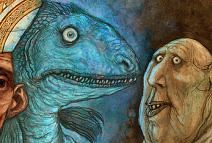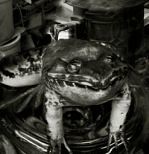Working on The Thackery T. Lambshead Cabinet of Curiosities
(Sneak peek detail from Ivica Stevanovic‘s amazing full-page art, to accompany the story “Relic” by Jeffrey Ford. A recent series here, too.)
Having finished up most of the editing on the stories and incidental text going into The Thackery T. Lambshead Cabinet of Curiosities, we started compiling the master document today. This also includes placement tags for images and creating a separate image key. The anthology is heavily visual and it wouldn’t make any sense to include even thumbnails in the text document. The image key also will contain all of the captions for images—very important because those captions will help contextualize not just the image but also, potentially, the story it accompanies.
Today and through the weekend, we’ll be working on the final detail work prior to turning in the anthology to Diana Gill at Eos. It’s always important to try to make the master document as consistent as possible format and style-wise, and to do last spell/grammar checks, read-throughs, etc. Our goal during this phase is to make the manuscript as clean for the typesetter and copy-editor as possible, and to give as clear instructions as possible not just about the images but about special cases in the text, like Arabic letters, which we always fear may drop out of the manuscript on the other end. Our friend Gio Clairval, who is in the antho but also an excellent translator, will be checking the German and French in a couple of manuscripts, too.
You can get to this point and get sloppy, and then your life and the publisher’s life are both more irritating and difficult when you get the typeset version back.
There’s also the challenge of finding high-res images for some stories. For example, Minister Faust needs us to find a Bosnian Course-Hair Hound photo to accompany images of Aleister Crowley and a stapler!! (Not that I’m complaining—we love a good challenge.)
One problem in compiling the manuscript is I keep either chuckling or having my breath taken away reading the material. Jeff Ford’s “Relic” just tickles both me and Ann to death, with its recursive lying (sorry, “fabrication”) and crazy sermons…and it’s just such a wise story, too, about relationships. And then I started replacing Mike Moorcock’s single quotes with doubles and kept cackling at this bit early in the story: “The small daughter of a Bermondsey tailor claimed that her half-grown cat Mimi had eaten a fairy. Of course no one would believe her even though she insisted she had seen Mimi nosing around a tiny leg. Rebecca, of course, was rightly punished for telling stories. But a few days later she came to her mother holding triumphantly a little human ear.” (Of course, just the title of Cherie Priest’s story, “Addison’s Clockroach,” cracks us up.)
Like I said, though, it’s not just laughs. There are serious pieces. Lev Grossman’s “…Roboticus the All-Knowing,” based on one of the original Mike Mignola illos, starts out absurd but ends up containing a fair amount of pathos. “The Gallows Horse” by Reza Negarestani is…well, it’s just genius and audacious. Alan Moore’s “Objects Discovered in a Novel Under Construction” could’ve just been a joke about his half-finished novel, but instead it’s very much a highlight of the book. Caitlin R. Kiernan’s key to a key is extremely creepy. Amal El-Mohtar’s “The Singing Fish” is a perfectly executed story about art and influence. Ted Chiang, N.K. Jemisin, Rachel Swirsky…I could go on and on.
One thing that I think makes this anthology superior to its predecessor The Thackery T. Lambshead Pocket Guide to Eccentric & Discredited Diseases is that we’ve provided contributors with several different ways to tell stories, ranging from the traditional to the more Borgesian—and the emotional range seems wider as a result.
The style of the various pieces of art is also more diverse. There’s certainly some neo-Victorian/Steampunk influence, but, ya know, Lambshead was only ten in 1910, so most of the stories and the artifacts cover various periods throughout the twentieth century. At last count, 20 to 25 different artists are contributing, with John Coulthart providing focus/cohesion through section title pages and piece work. The format will be an oversized hardcover with the cover printed right on the boards.
In short, this thing is going to be Mighty. (Full disclosure of TOC will occur in the next couple of weeks, on another website…)
P.S. Can we just say…our editor Diana Gill and Will Hinton at Eos have been wonderful.
(Detail from a J.K. Potter piece in the antho.)


2 comments on “Working on The Thackery T. Lambshead Cabinet of Curiosities”
I can’t believe I have to wait months to read this! I wantss it now, preciouss!
It feels like it really will be a Kunstkammer itself, not just a catalog of one; that to open it up will be to allow objects to tumble out.
It’s wonderful to read about what goes on behind the scenes, and pretty awing to think of how meticulous you have to be, how many instances of measure-twice, cut-once you have to go through. Really freakin’ cool.
Amal–I think you’re right about it all tumbling out! This measure-twice/cut-once is very calming. You are concentrating so much on it that it’s nice. The uni-focus.
Jeff
Comments are closed.